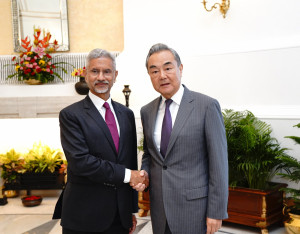National
A viral video sparks a social media conversation about misinformation, and identity
As of Monday evening, the clip had been viewed over 440,000 times and shared by over 6,500 Facebook users—an example of just how quickly misinformation can spread on social media. Based on the comments, it seems, a majority of viewers believed Wagle’s sweeping assertions. Only a few questioned the legitimacy of her claims.
On April 24, Namrata Wagle, a Birgunj native, went live on Facebook from outside the District Administration’s Office to show viewers what she described as a “shocking scene.”
In the six-and-a-half-minute video, Wagle points her camera at the people waiting in line outside the DAO, and claims that they are all Indian nationals, trying to illegally obtain Nepali citizenship.
“All these people in line, they are all Indians, none of them are Nepali. They have all come from India,” she says at the beginning of the clip. “Ever since the government relaxed our citizenship laws, the crowd of people has multiplied. There is no space for us Nepalis to even walk.”
Wagle does not speak to a single person in the queue, nor does she interview the Chief District Officer, whose office she has accused of handing out citizenship to Indian citizens. The only person she talks to is a shop owner who confirms her assumptions.
As of Monday evening, the clip had been viewed over 440,000 times and shared by over 6,500 Facebook users—an example of just how quickly misinformation can spread on social media. Based on the comments, it seems, a majority of viewers believed Wagle’s sweeping assertions. Only a few questioned the legitimacy of her claims.
“On what basis did you determine that all the people standing in line are Indians,” commented one Facebook user. “You need to change your mentality which assumes non-fair skinned people are non-Nepalis. It’s easy to spread falsehoods without any proof, but difficult to tell the truth.”
In an interview with the Post, Parsa Chief District Officer Narayan Prasad Bhattarai said Wagle’s claims that Indian nationals have been crossing the border in droves to obtain Nepali citizenship are “completely false”.
“The video is just spreading falsehoods,” CDO Bhattarai told the Post. “While the number of citizenship applicants has increased in recent weeks following the Home Ministry’s order, each application is carefully examined and approved only after all required proof and documents have been submitted.”
Earlier this month, the Home Ministry had circulated an order asking Chief District Offices to grant citizenship by descent to the children of those individuals who had obtained citizenship by birth.
For some locals, the claims made in the video underline just how narrowly defined a Nepali is.
“Do all Nepalis have to have fair skin? Do all of them have to be able to speak and write in Nepali?” asked local activist Aashu Saraf. “People in Birgunj speak Bhojpuri and those from rural parts can barely speak the Nepali language because they don’t use it in their daily conversation. People here also prefer Hindi as a lingua franca than Nepali.”
The logic that people who speak in Hindi are non-Nepalis is deeply flawed, said Sardul Bhattarai, a local student.
“Just as a person riding in an Indian vehicle doesn’t make him an Indian, likewise a person who speaks Hindi shouldn’t automatically be deemed a non-Nepali,” said Bhattarai.
On Twitter, where the video was shared by a user named Jeevan Shrestha on April 27, people expressed concerns over the possible impact of such misinformation.
“This is scary. A woman called Namrata Wagle pretends to be a journalist and spreads disinformation that is shared endlessly. Not once does she verify her own claims that the people in the queing [sic.] for #citizenship are Indian. What does a #Nepali look like?,” tweeted journalist Subina Shrestha in response to the video.
While it’s hard to immediately ascertain the impact of such a video, researchers say the danger of misinformation lies in the fact that there’s no possible way to reverse its impact. Only a handful of the people who have seen the original will be privy to a correction, say researchers.
“It’s hard to predict when and how this video will impact society,” said Santosh Sigdel, an advocate. “But there are plenty of examples in the world that show how misinformation spread through social media can result in extremely untoward consequences.”
In India, false rumours spread on WhatsApp have resulted in the lynching of at least a dozen individuals. In Sri Lanka, the proliferation of rumours and disinformation on social media led to communal violence last year. In Myanmar false information and hate speech spread on Facebook was found to be responsible for stoking violence against the Rohingya ethnic group.
“Every individual has the right to freedom of speech,” said Sigdel. “We cannot say only journalists have the right to disseminate information. But people need to be mindful and wary of the potential consequences their messages may have.”
Bhusan Yadav contributed reporting.




 19.28°C Kathmandu
19.28°C Kathmandu
















